
Tibetan prayer flags / Photo by Andreas Berger at Unsplash
Movies about climbing Mount Everest always show prayer flags – five pieces of solid colored fabric strung together, blowing in the wind. The meaning behind them is ancient and honors the individual, the family, the community, and the earth.
From my Buddhist friends, I’ve learned that the Buddhist approach to spirit is through the qualities of an enlightened mind. Among those qualities are Compassion, Fearlessness, Harmony, Strength, Peace, and Freedom.
Many spiritual systems see connections among colors, elements, and directions. Thousands of years ago, the shamans of Tibet explored the connection between color and energy. They connected blue with sky or space, white with air or clouds, red with fire, green with water, and yellow with earth. A balance of elements was known to bring harmony to the environment.
Prayer flags were, and still are, an honored way to work with these energies. Words, prayers, and auspicious symbols are printed in woodblock text on rectangles of fabric. Sewing the flags to the string is, in itself, designed to be a meditative practice. Once strung in traditional order (left to right: blue, white, red, green, yellow), the flags are displayed outside homes, across rivers and mountain passes, places of danger, and places of spiritual practice. The flags are displayed outside because that’s where the wind lives.
Like a horse, the wind carries the vibration of color, word, and symbol across the countryside, up the mountains, and into the clouds bringing happiness, long life and prosperity to the one who strung or planted the flags and to all people and places within energetic reach. One of the most widely recognized kind of prayer flag is called “Lung-Ta.” Translation: Wind Horse.
I first used prayer flags for a wedding ceremony. As often happens, my couples inspire new rituals. Several years ago, I was the officiant for Jennifer and Chris. They were exploring Buddhism and wanted to introduce their guests to the spiritual path they, themselves, had found so enlightening. They also wanted a unique wedding ceremony. And they were open to ideas. My ideal couple.
Just as in two other rituals I created, “Gifts from the Trees” and “Garden Gifts,” I introduced the Lung Ta ritual during the ceremony by drawing parallels to the gifts newlyweds might receive from their registry and the gifts that represent qualities desired in a marriage, such as peace, wisdom, harmony, health, and prosperity.
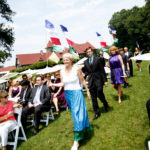
Wedding ritual with prayer flags / Photo by Kevin Kelley
As with the other gifting rituals, I designed Lung Ta so that it would involve a selected group of guests. For this ritual, either six or twelve guests. Jennifer and Chris were married outside, overlooking the river at St. Clements Castle in Portland, CT. It wasn’t feasible to hang the prayer flags during the ceremony. So I attached a string of five flags to a bamboo pole. Each presenter carried a pole. Six guests meant six poles and six sets of flags, five flags to a pole. The Wind Horse ran wild that day and the visuals were stunning!
During the ceremony, I introduced the ritual to all the guests, much in the same way I just described it to you. I let them know that the flags would be present at the reception so they could write their own blessings on the flags. Unlike traditional prayer flags, the ones I make for the wedding are plain. Guests can write or draw on the flags. The key is that every blessing be given for the benefit of all. I tell the guests to add their blessings and say: “May all beings everywhere receive benefit and find happiness.”
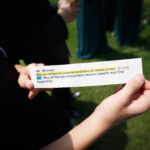
Flag presenters are given pre-written blessings to ensure uniformity in the ritual
Once I’ve introduced the Wind Horse, I call for the prayer flags. Six people form a single line and walk down the aisle. The leader stops at the first row of seats. One by one, each person recites a prewritten blessing for the couple. After each blessing, all the other presenters respond in unison with the refrain: “May all beings everywhere receive benefit and find happiness.” Guests are encouraged to join in.
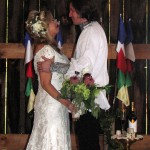
Rustic wedding of Christina and Cole in Litchfield CT / Officiant Zita Christian
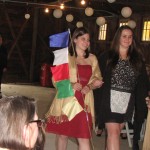
Prayer flag presenters can enter in pairs / Photo by Carol Chaput
The person giving the blessing “plants” the bamboo pole in one of the two umbrella stands on either side of the couple and waits to the side until all blessings have been given and all flags have been planted. Then the guests return to their seats.
When I do this ritual with twelve guests, they come down the aisle in pairs. One holds the pole with the flags. The other recites the blessing.
Here are the blessings I wrote.
May you have both longevity and good health
May you have both knowledge and wisdom.
May you have both prosperity and generosity.
May you always be protected and have no reason to fear.
May you always give and receive compassion.
May your home be filled with harmony and friends.
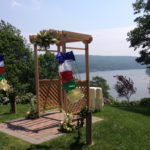
Prayer flags in stands weighted with marbles
The two containers I used to hold the bamboo poles are simply PVC pipes attached to flanges and spray painted to look like stone. I weighted them down with mesh sacks of glass marbles.
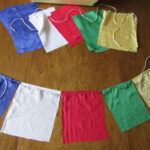
Prayer flags sewn by hand to satin cord
When I make the flags, I attach them to a satin cord using an old-fashioned needle and thread. I attach them with knots and glue to bamboo poles, always mindful that the flags need to begin and end at approximately the same spot on each pole. I won’t kid you. This is a labor-intensive ritual to create. That’s why I don’t offer it any more.
That doesn’t mean you can’t create the ritual for yourself. There are a number of shops on Etsy where you can purchase traditional and nontraditional prayer flags. You can purchase fabric, or repurpose old linens, and make your own flags.
A RITUAL FOR CHILDREN
You can easily adapt this ritual for children. Just make the flags with colored paper. Tape them to a cardboard tube. An empty roll of paper towels works just fine. Although the paper flags won’t fray in the wind, I’m sure you can see the value in having children draw, write, or speak the blessings they want to share with others. The blessings can be similar to saying prayers before bedtime, or making magical wishes. In fact, it’s a good idea to make the blessings fantastical! For the bully at school, a blessing might be: “May the Monster of Hugs and Kisses show you so much love you can’t see anything but love.”
Adults can use the power of such fantastical blessings, too. More on that later.
DOROTHY GALE, THE WIZARD OF OZ, THOSE MAGIC SHOES
In the meantime, take a walk through the stacks at Barnes & Noble or the YA section of your local library. You’ll see that children and young adults love stories that contain rituals. As it turns out, so do older adults, especially this one.
Growing up, my imagination was nurtured in books. Like many of you, I’ve always loved to read. During the summer between the 3rd and 4th grades, I read The Wizard of Oz by L. Frank Baum 34 times. I’m not exaggerating. I read the last page and flipped right back to Chapter 1 again and again and again. Never before or since have I felt such an obsession. I remember that with each reading, I felt certain that, this time, I would find a clue and it would lead me to something important, something vital for my future. I couldn’t wait for our family’s next summer vacation on my grandparents’ farm in South Dakota, complete with a root cellar, tornadoes, and a neighbor’s shed that had once been dropped on their farm courtesy of a twister. I did spend many a summer in South Dakota but came no closer to finding a clue.
Of course, the shoes were the obvious clue. But in Baum’s telling, they were silver. Hollywood changed them to ruby slippers. How important could those shoes really be if the uppers could be either metal or stone? There had to be something else.
Years later, I learned about the Braided Man, a character in one of Baum’s subsequent books, Dorothy and the Wizard in Oz. The Braided Man is an eccentric being who lives in Pyramid Mountain in the underground Valley of Voe. His white hair is longer than he is tall. He wears it in multiple braids, each tied with a colorful ribbon. He’s known for making useful holes for buttons, clever holes for donuts, imported holes for Swiss cheese, and massive stacks of post holes – so many holes they all collapsed and he fell into the mountain where he now lives. He also makes exquisite rustles for ladies’ gowns and fine flutters for flags and buntings.
The Braided Man sees the value in the invisible. The hole makes a donut easy to dunk in a cup of cocoa. The hole in a button provides a path to attach it to a coat. With every movement, the rustle of a lady’s silk gown announces its quality. With every flutter, the meaning of a flag draws attention, gains momentum, and travels through the minds of millions.
I’m sure you’ve seen the iconic photo of American soldiers planting the flag on Iwo Jima. Planting the flag was a visible act. The invisible intent was to proclaim survival, demonstrate resilience, claim victory. I was born and raised in a military family. The first time I saw that photo, I recognized an act of patriotism. It would be years before I realized that planting that flag was the visible part of a ritual.
Ritual: A visible act with performed with invisible intent.
Eventually, I realized what was really happening in that scene when Glinda the Good Witch tells Dorothy how to get what she wants. Dorothy’s desire, her invisible intent, is to go home. She envisions her Aunt Em and Uncle Henry and how much she longs to be with them again. As instructed, Dorothy performs a visible act. She clicks her heels three times. Woosh! She’s back in Kansas.
For me, the whole story was about personal empowerment for all the heroic characters, especially Dorothy. I recognized that the first time I read the book. It would be years before I recognized that clicking her heels was the visible part of a ritual. It was in performing the ritual that Dorothy claimed her power. Looking back, I suspect that’s when my love of ritual began. And that would explain why I liked that book so much.
VISIONARY ACTIVIST CAROLINE CASEY
A few days ago, I was listening to astrologer and visionary activist Caroline Casey on her website Coyote Network News.com. She was talking about the frustration many of us feel about the political environment in the White House. In her true, coyote trickster way, Caroline said we need a way to metabolize political poison because to complain without offering a remedy is to be part of the problem. What kind of remedy can we offer? Blessings.
Caroline assures us that the blessings don’t have to be realistic. In fact, the more fantastical, the better. I’m following her advice. When I hear a politician deny responsibility for his acts of cruelty, I do this simple ritual:
My invisible intent is to open the heart of the perpetrator. My visible action is to hold the person’s image in my mind while saying this blessing: “May you find yourself alone in the forest of transformation surrounded by owls who will open your eyes to your ignorance and impart their wisdom that you might lead with respect and compassion for all people.” Fantastical? Sure. Meaningful? To me, absolutely.
Just as Tibetan prayer flags are believed to carry blessings to the creation all around them, I believe that the energy of my blessing can travel. Call it intentionality. Call in mindfulness. Call it spiritual physics. Call it ritual.
To whom would you give a blessing? A friend about to undertake a journey? A family member who has been estranged? A stranger whose dreams for a better life are so much like your own? What would the blessing be? Make it fantastical! If you’re willing to share it with others, email it to me at Zita@RitualRecipes.net
If you’ve already developed a ritual practice, you know that rituals can connect us with nature, humanity, the ancestors, and with the power in our deepest selves. If you’re new to the practice of ritual, the podcast Ritual Recipes offers safe and simple ways to begin.
Join me. Whistle to the Wind Horse. Let’s change the world.

